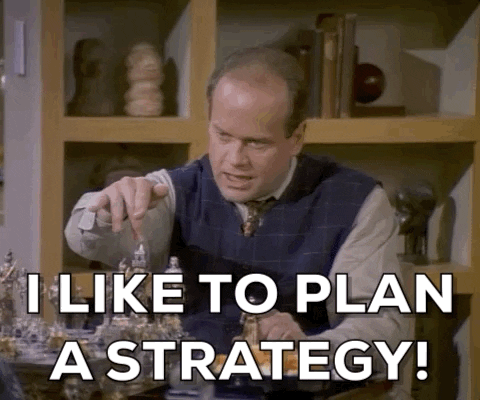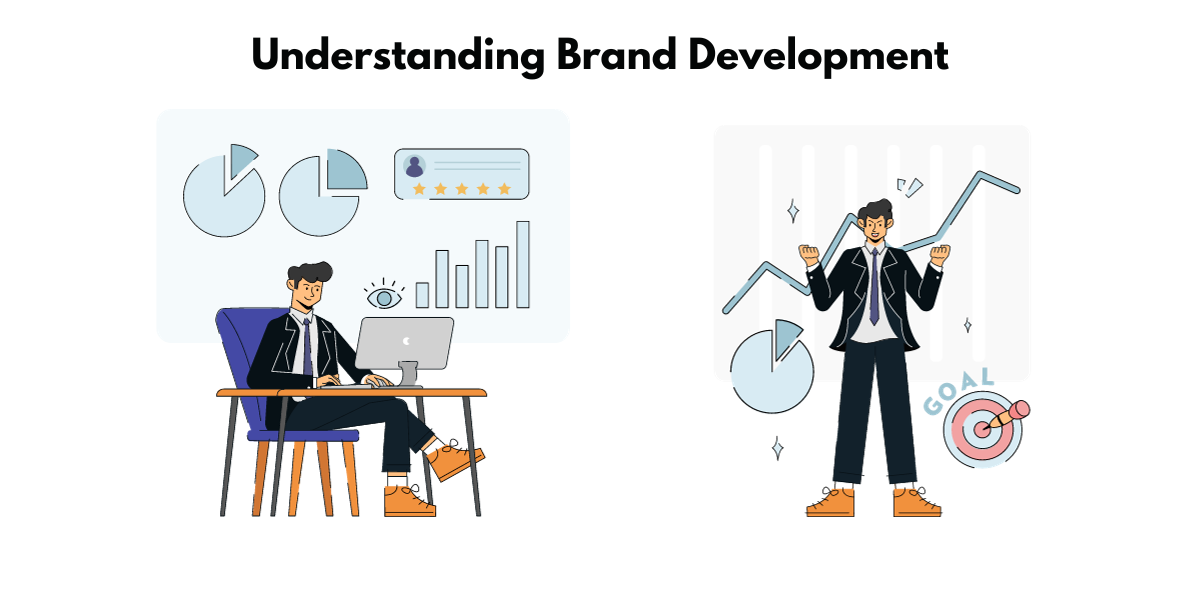Understanding Brand Development
Brand development is a continuous, strategic process of building and strengthening a brand’s reputation, aesthetic, and perceived value. It goes beyond conceiving a catchy name or a compelling logo, delving deeper into the core of what makes your brand unique and resonant in an increasingly competitive market. The end goal of brand development is not only to establish a recognizable identity but also to build consumer trust and foster robust and long-term customer relationships.
Importance of Brand Development For Your Business
Investing time and resources into brand development is crucial for any business, regardless of its size or industry. It helps shape the way your brand is perceived by consumers, dictating whether they choose your product or service over a competitor’s. Beyond enhancing market recognition, a well-developed brand can drive customer loyalty and boost business growth. It enables you to tie all aspects of your business together into a unified, coherent whole, showcasing an authentic and compelling value proposition.

Step 1- Discover the Purpose Behind Your Brand
The significance of defining your brand’s core message
Creating a core message is a fundamental step in the brand development process. Your brand message communicates who you are, what you offer, and why people should care. It’s more than just words on a page, it sets the tone for all your brand communication and forms an intrinsic part of your brand identity. The core message should be succinct, genuine, and emotionally compelling, resonating with your audience’s needs, aspirations, and values.
How to create a mission statement
- Identify the purpose – Start by identifying why your business was started. What problem did you intend to solve for your audience? This forms the foundation of your mission.
- List core strengths – Analyze your brand’s strengths that enable you to deliver a unique value proposition to your audience.
- Determine Values, Benefits, and Quality – Summarize your brand values, the benefits you offer and the quality you promise in your products or services.
- Make it resonate – Formulate a succinct yet inspiring mission that resonates with both, you and your target audience.
Step 2- Know Your Audience
How to identify and research your target customers
- Analyze your Current Customers: Look into your existing customer base. Why do they buy from you? What are their common characteristics? Are there any shared needs or challenges among them? This establishes a base segment for your target market.
- Survey and Talk to Your Customers: Direct interaction is a valuable source of information. Surveys, interviews, and informal conversations can provide insights into what your customers value about your brand, their motivation to choose you, and their overall perception of your brand.
- Research Online Behavior and Discussions: Platforms such as social media, forums, and even review sections on your site or other sites can offer invaluable information about what your target audiences are saying about your brand and competitors.
- Use Analytical Tools: Leveraging data analysis tools can provide demographical and behavioral insights on who is interacting with your brand, their interests, geographic location, age, and much more. This helps in creating more specific customer personas.
- Consider the Market Conditions: Always consider the wider market conditions, how they could impact your brand, and the potential shifts in your target market. Stay flexible and adapt your targeting strategy as needed.
The role of audience in forming a unique brand voice
Knowing your audience well is integral to creating a unique brand voice. Your brand voice enables you to communicate effectively with your customers, influencing how they perceive and interact with your brand.
Understanding your audience helps you tailor your brand voice to resonate with them, catering to their preferences, needs, and lifestyle. For instance, a brand targeting young adults may adopt a friendly, conversational tone, while one catering to executives might opt for a more formal, authoritative voice.
In essence, your brand voice should be an authentic reflection of your brand’s personality and values, yet flexible enough to evolve with your audience’s changing needs.

Step 3- Create Strong Brand Identity and Guidelines
Building out your brand – name, logo, and tagline
Constructing a brand involves the development of essential elements like your brand’s name, logo, and tagline.
Name: Your brand’s name is its first point of identification. It should be unique, memorable, user-friendly, and imbued with a sense of what your business represents. The name should resonate with your target audience and align with your brand values.
Logo: A well-designed logo is a visual representation of your brand that should be immediately recognizable. It appears on everything related to your business, becoming the visual recognition of your brand’s promise. Aim for a logo that is simple, versatile, relevant, and timeless, creating a lasting memory in the minds of consumers.
Tagline: A meaningful tagline complements your brand name and logo. It encapsulates your brand’s mission, promise, and core benefits in a language that resonates with your audience.
Building these elements is a combination of science and art, often requiring the help of creative professionals like designers or branding agencies. They can help in creating a unique and consistent visual and verbal brand representation that stands tall against competition and evolves with your brand over time.
Consistency as key in maintaining brand identity
It’s crucial not just to build your identity but also to ensure that it remains consistent wherever your brand gets represented — from your website, social accounts, and marketing campaigns, to product packaging, customer service, and even employee communication. Referencing your brand strategy can aid in making consistent decisions about identity or marketing.
Consistency is, therefore, a driving force in making your brand stand out, influencing brand recognition and eventually loyalty. While maintaining this consistency, also remember that the world is ever-changing and your brand must remain flexible and adaptive to stay relevant, without deviating from its core identity.
Step 4- Define Key Quality & Benefits Your Brand Offers
Identifying the unique traits that differentiate your brand
- Understand your Brand Vision: Start by identifying your brand’s core values and mission statement. It defines what you stand for, your brand personality, and what makes you unique.
- Identify your Unique Value Proposition (UVP): UVP is the unique mix of product/service features, benefits, and values that your brand offers, distinguishing it from competitors. Ask yourself: What makes your product/service better or different from others? Why should customers choose your brand over others?
- Understand your Audience: Decipher which traits resonate most with your audience. It helps in aligning your unique traits with your audience’s needs or wants, creating a compelling reason for them to choose your brand.
- Analyze your Competitors: Bring your competitors into the equation. What are they doing? How are they differentiating their products/services? Use this information to establish a distinction for your own brand.
Showcasing the benefits customers receive from your offerings
- Focus on Pain Points: Identify your audience’s pain points and highlight how your product or service solves them. This could range from cost-saving solutions to simplifying complex processes or even saving time.
- Emphasize Emotional Benefits: Talk about the emotional advantages your customers will get from using your product or service. For example, will it give them peace of mind? Will it let them feel more in control of their lives? Emotional benefits hold great power in decision-making processes.
- Tailor benefits to your target audience: Speak directly to your specific audience. The benefits for a CEO may be different than for a middle manager. Know who you’re talking to and highlight what would be most attractive to them.
- Leverage Social Proof: Share testimonials, reviews, case studies, and success stories to demonstrate how customers have benefitted from your offerings in the past. Social proof gives credibility to the benefits you’re promising.
- Use Visuals: Pictures, infographics, videos can make it much easier for your audience to grasp what advantages they can expect. Visuals can illustrate your product or service in action, making its benefits easily recognizable.

Step 5- Craft a Compelling Brand Story
Build a brand story around messaging – how and why?
Building a brand story around your messaging is an effective way to engage your audience while staying true to your brand’s identity and values.
How to build a brand story around messaging:
- Establish Your Key Messages: Your key messages should highlight your product’s unique features, fulfilling customers’ needs or solving their problems.
- Define Your Brand’s Purpose: This is the reason ‘why’ your brand exists. It can inform both your overarching brand story and act as a guidepost for all messaging decisions.
- Develop Your Brand Personality and Tone: Customers should be able to recognize the personality and tone in all your brand conversations. A consistent and appealing brand voice helps in engaging the audience and enhancing recall value.
- Keep it Genuine and Authentic: Credibility plays a crucial role in successful brand storytelling. Your story must be truthful, reflecting your brand’s real journey, beliefs, and values.
Why to build a brand story around messaging:
- Foster Emotional Connection: An engaging brand story built around your messaging can evoke emotions, fostering a deeper connection with your audience and stimulating loyalty.
- Differentiate Your Brand: A compelling brand story sets your brand apart from the competitors, showcasing the unique elements only you can deliver.
- Enhance Brand Recall: A unique brand story makes your brand more memorable. When customers connect a story to your brand, it’s likely to elevate your brand recall.
- Drive Engagement: A brand’s story captures the essence of its past, present, and future. This narrative invites your customers to be part of your brand’s journey, boosting engagement and creating brand advocates.

Step 6- Research Competitor Brands within Your Industry
Understand your business’s position in the industry
- Competitor Analysis: This entails conducting a SWOT analysis, which examines your Strengths, Weaknesses, Opportunities, and Threats within the context of the industry. Consider where you outperform your competitors and where you fall short—these factors contribute to your unique positioning.
- Customer Relationship Evaluation: Explore the relationship you have with your customers and understand the value your customers attach to your brand. This can involve knowing what problem your product solves, what they currently use to solve it, and why they might consider your product better than others.
- Positioning Statement: Creating this statement is an effective way to understand your business’s position in the industry. A good positioning statement is unique to your company, identifies your target audience, and focuses on the main benefits your company offers, explaining why it’s a better choice than the competition.
- Analyze Market Trends: Constantly keep an eye out for changing industry trends. What new opportunities are surfacing? What competitor offerings have gaps that you could fill? The answers can help you adjust your positioning to capitalize on these shifts.
Step 7- Management of Your Brand
Tools for building and managing a successful brand
The process of building and managing a successful brand can often seem complex, but leveraging the right tools can enormously simplify the process. Here are some useful tools that can assist you:
- Logo Creators: Tools like Canva and Adobe Spark offer intuitive interfaces and templates to design unique logos and visual elements.
- Social Media Management: Platforms like Hootsuite, Buffer, and Sprout Social help manage, schedule, and monitor social media posts across multiple channels, gathering insights into audience engagement.
- Email Marketing: MailChimp, Constant Contact, and ConvertKit are popular email marketing tools that can help manage subscribers, create engaging emails, and track performance.
- SEO Tools: SEO platforms like Moz, SEMRush, or Ahrefs help identify key SEO opportunities, track rankings, and analyze competitors to enhance your online presence.
- Customer Relationship Management (CRM): Salesforce, HubSpot, and Zoho CRM can keep track of customer interactions across multiple touchpoints, helping build a consistent and personalized brand experience.
- Content Management System (CMS): Tools like WordPress, Joomla, or Wix help manage digital content, giving you control over your brand’s online presence.
- Design Tools: Tools like Adobe Photoshop or InVision can aid in creating and editing visual elements, ensuring consistency in visual branding.
- Online Reputation Management (ORM): Tools like Mention, Google Alerts, or Yext can help monitor mentions of your brand online, enabling you to manage your brand’s reputation proactively.
Choosing the right tools mainly depends on your business size, budget, and specific needs. By eliminating repetitive tasks, automating processes, and arming you with actionable intelligence, the right tools can significantly aid in building and managing a successful brand.

Step 8- Integrate Your Brand into Every Aspect of Your Business
Unleashing the power of seamless brand integration
- Consistent Messaging: Ensure your brand’s key message, tone of voice, and visual elements are consistent across all communication channels. Whether it’s your website, social media, emails, or in-store experience, they should all deliver a harmonious message about your brand.
- Unified Visual Branding: Maintain a consistent visual identity across all platforms, including your logo, colors, images, and typography.
- Integrated Marketing: All your marketing strategies, whether digital or traditional, should be aligned and work together toward the same goals. This includes social media, content marketing, pay-per-click (PPC) advertising, email marketing, etc.
- Align Internal Branding: Internal branding should reflect your external image and vice versa. This means your HR practices, company culture, and employee behavior should uphold your brand’s personality and values.
- Customer Experience (CX) Integration: Provide a seamless customer experience at every touchpoint of the customer’s journey. The quality of service must be consistent across every interaction – from discovery and consideration to purchase and after-sales service.
Tracking progress and making necessary adjustments
The final and an essential step in brand development is tracking your progress and making the necessary adjustments to maintain and enhance your brand’s growth.
How to Track Progress?
- Metrics: KPIs like Customer Acquisition Cost (CAC), Customer Lifetime Value (CLV), Net Promoter Score (NPS), and social media engagement can provide valuable insights into your brand’s performance.
- Digital Analytics: Tools like Google Analytics can help monitor online traffic, track website performance statistics, and give insights into customer behavior.
- Surveys and Feedback: Regularly conducting surveys and collecting feedback can offer insights into customer satisfaction and perception of your brand.
- Social Listening: Social media listening tools can monitor brand mentions and sentiment online, helping you gauge public perception and react appropriately.
Making Necessary Adjustments Once you’re tracking progress, you’ll likely notice areas where your brand isn’t performing as expected. This is when you need to take action and make necessary adjustments. This could involve tweaking your marketing strategies, improving your offerings, or revamping your brand identity.

FAQs about Brand Development
What is the difference between brand development and branding?
While often used interchangeably, ‘brand development’ and ‘branding’ have different connotations in the context of marketing.
Brand Development is a more strategic, long-term process. It involves defining the bedrock of your brand – your mission, vision, values, and unique value proposition. It’s about conceptualizing what you want your brand to represent and planning how you’ll cultivate that image over time. Brand development involves steps like identifying your target audience, creating a brand story, and distinguishing your brand from competitors.
On the other hand, Branding is about bringing the brand you’ve developed to life. It’s the tangible manifestation of your brand development efforts. Branding is more design-oriented and execution-focused. Elements like your logo, website design, marketing collateral, color schemes, typography, product packaging, and overall visual identity fall under the realm of branding.
Which brands excel in the brand development process?
Certain global brands have truly excelled when it comes to the brand development process, leveraging their distinct brand identity to vie for customer loyalty and engender long-term success:
- Apple: Apple stands out for its commitment to innovation, design, and minimalism. Their products not only serve practical purposes but also represent a specific lifestyle and image, making Apple a status symbol.
- Nike: Embracing the slogan “Just Do It”, Nike has built a highly recognizable brand around motivation, performance, and the spirit of athleticism. It’s more than selling shoes; it’s about promoting a fitness lifestyle.
- Coca-Cola: Coca-Cola has excelled with its consistent brand messaging promoting happiness and positivity, successfully creating emotional resonance with the audience.
- Starbucks: Beyond selling coffee, Starbucks has developed a strong brand around creating a unique, cozy ‘third-place’ atmosphere between work and home.
- Tesla: Tesla has not only redefined the electric car industry but has developed a brand synonymous with luxury, innovation, and eco-friendliness.
These brands have invested time and resources in strategic brand development, creating distinctive identities that resonate with their target audience, remain true to their core values, and set them apart from the competition. Their success depicts the significance of a well-executed brand development process. These brands’ stories serve as instructive case studies for businesses embarking on their brand development journey.




![10 [Great] Tips to Help You Create an Effective Real Estate Branding](https://www.profilemonk.com/wp-content/uploads/2022/08/real-estate-branding-how-to-create-a-brand-for-your-real-estate-business-768x384.png)


